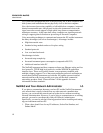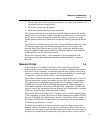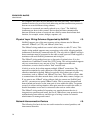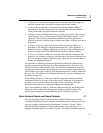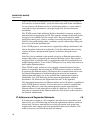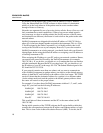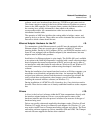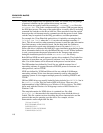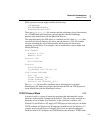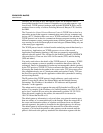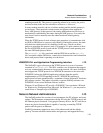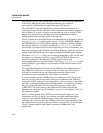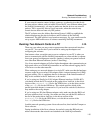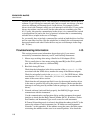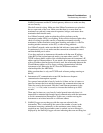
2640A/2645A NetDAQ
Users Manual
I-10
Packet drivers support only one protocol at a time. As a result, only one package
of protocol software can use a packet driver at any one time.
Packet drivers are usually loaded by executing a *.com or an *.exe file in the
autoexec.bat. This loads a terminate and stay resident (TSR) program during
the DOS boot process. The setup of the packet driver is usually done by including
command line switches on the driver load line. There must be at least one switch
that assigns the soft interrupt used to communicate with the protocol stack. Other
switches may be required to set the IRQ, port address, and other parameters.
For example, the 3Com EtherLink packet driver is loaded by executing the line
3c5x9pd.com 0x60, where the 0x60 sets the soft interrupt to number 60
(hex). This driver needs no other parameters because it reads the other information
from flash memory on the interface board. On the other hand, the Cabletron
adapter packet driver reads setup information from a file named e21pd.cfg.
Since each driver is different, the NetDAQ Logger installation program has packet
driver information built-in for only the Ethernet drivers we sell. If other hardware
is used, you must enter the proper information in the Trumpet setup window
during the installation process or edit the autoexec.bat file directly.
Both ODI and NDIS are multi-protocol, packet driver standards. They both allow
operation of more than one set of protocol software "over" the driver at the same
time. Use of this feature will be discussed in the protocol section below.
The ODI standard was defined by Novell for use with the netware line of
networking software. It supports the native IPX/SPX protocol of netware and
other protocols, such as TCP/IP.
NDIS was defined by 3COM and Microsoft for use with the LANManager
networking software. It has since become commonly used by other network
operating systems. It also supports multiple protocols, including IPX/SPX and
TCP/IP.
ODI and NDIS drivers are usually loaded by being included in a DEVICE= line in
the config.sys file. This line loads a DOS-level driver. There are a few
implementations of the NDIS driver as a Windows VxD level driver. The NDIS
driver used with the Windows for Workgroups version of MS Windows is a
Windows VxD.
The setup information for NDIS drivers is contained in a file called
protocol.ini that must be in the same directory from which the driver is
loaded. This file contains sections describing the driver characteristics and the
protocols that may be operating over the driver. For example, a driver
characteristic section might look like this:
[EtherLinkII]
DRIVERNAME=ELNKII$
INTERRUPT=5
TRANCEIVER=INTERNAL
IOADDRESS=0x300



